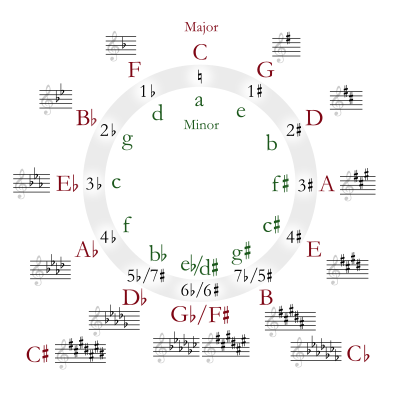Major scale - Simple English Wikipedia, the free encyclopedia
In music theory, the major scale or Ionian scale is one of the diatonic scales. It is made up of seven separate notes, plus an eighth which is the same as the first an octave higher. In solfege these notes correspond to the syllables "Do, Re, Mi, Fa, Sol, La, Ti/Si, Do". The simplest major scale to write or play on the piano is C major, the only major scale not to require sharps or flats, using only the white keys on the piano keyboard:
Shape
[change | change source]
A major scale is a set of steps in the order "Whole:Whole:Half:Whole:Whole:Whole:Half" (tone, tone, semitone, tone, tone, tone, semitone). Western scales do not skip any line or space on the staff, and they do not repeat any note with a different accidental. This means that the key signature of the scale will feature just sharps or just flats.
Names of scale degrees
[change | change source]- 1st – Tonic- key note
- 2nd – Supertonic
- 3rd – Mediant
- 4th – Subdominant
- 5th – Dominant
- 6th – Submediant
- 7th – Leading Tone
- 8th – Tonic ( or Octave)
The circle of fifths
[change | change source]The Circle of Fifths was first described in 1728 by Johann David Heinichen in his book Der General-bass. It has been used ever since as a way to show the relations between scales.
The numbers inside the circle show the number of sharps or flats in the key signature, with the sharp keys going clockwise, and the flat keys counterclockwise from C major (which has no sharps or flats.) The circle depends on enharmonic relationships in the circle, which is six sharps or flats for the major keys of F♯ = G♭ and D♯ = E♭ for minor keys (Drabkin 2001). Seven sharps or flats make major keys (C♯ major and C♭ major) that are more easy to spell with five flats or sharps (as D♭ major or B major).
Harmonic properties
[change | change source]The major scale is used more often than the minor scale in Western music because of its unique harmonic properties. For example, the major third is much stronger in the harmonic series (it is the 5th, 10th and 20th harmonic – see below) than the minor third (the 19th harmonic).
Related pages
[change | change source]- Minor scale
- Enharmonic
- Equal temperament
- Just intonation
- Lydian mode
- Major and minor
- Music theory
- Tetrachord
References
[change | change source]- Bower, Michael. 2007. "All about Key Signatures Archived 2010-03-11 at the Wayback Machine". Modesto, CA: Capistrano School (K–12) website. (Accessed 17 March 2010)
- Drabkin, William. 2001. "Circle of Fifths". The New Grove Dictionary of Music and Musicians, second edition, edited by Stanley Sadie and John Tyrrell. London: Macmillan Publishers.
- Jones, George Thaddeus. 1974. Music Theory: The Fundamental Concepts of Tonal Music Including Notation, Terminology, and Harmony. Barnes & Noble Outline Series 137. New York, Hagerstown, San Francisco, London: Barnes & Noble. ISBN 0064-60137-4
- Kennedy, Michael. 1994. "Key-Signature". Oxford Dictionary of Music, second edition, associate editor, Joyce Bourne. Oxford and New York: Oxford University Press. ISBN 0198691629.
Other websites
[change | change source]- Proper fingering of the major and minor scales on the piano
- Listen to and download harmonised Major scale piano MP3s
- The major and pentatonic scales on the guitar Archived 2015-10-22 at the Wayback Machine in several positions
- The major scale for guitar in one position, with derivation
 |
| ||||||||||||||||||||||||||||||||||||||||||||||||||||||
| The table shows the number of sharps or flats in each scale. Minor scales are written in lower case. | |||||||||||||||||||||||||||||||||||||||||||||||||||||||


 French
French Deutsch
Deutsch
